Rhaphidophora tetrasperma, commonly known as Mini Monstera, Monstera ginny, Monstera Maxima, Philodendroan Ginny, or Philodendron minima, is a lovely houseplant with deeply split green leaves and at times rhombic holes adjacent to the midrib.
Besides the green form, you can go for the variegated ones (albo, mint, and aurea).
We’ve insight on Rhaphidophora tetrasperma, including description and appearance, care, and problems like leaves turning yellow, having brown tips or edges, or black spots. We will also give you a comparison with Monstera deliciosa and Rhaphidophora pertusa.
That is not all. We will also teach you how to propagate Rhaphidophora tetrasperma in water or soil.

Contents
- Overview
- Description and appearance
- 1. Growing habits
- 2. Growth rate and size
- 3. Rhaphidophora tetrasperma leaves
- 4. Stems
- 5. Flowers
- Variegated Rhaphidophora tetrasperma
- 1. Rhaphidophora tetrasperma albo variegata
- 2. Rhaphidophora tetrasperma Aurea
- 3. Rhaphidophora tetrasperma Mint
- Tissue culture Rhaphidophora tetrasperma
- Rhaphidophora pertusa vs. tetrasperma
- Rhaphidophora tetrasperma vs. Monstera deliciosa
- Mini Monstera care
- Rhaphidophora tetrasperma Propagation
- 1. What you need
- 2. How to propagate Rhaphidophora tetrasperma in
- 3. Philodendron ginny water propagation
- Is Rhaphidophora tetrasperma toxic to cats, dogs, and humans?
- Problems and issues
- 1. Pests that affect Monstera minima
- 2. Diseases
- Other problems
- Finding Rhaphidophora tetrasperma on sale
- Mini monstera prices
Overview
Rhaphidophora tetrasperma, popularly known as mini Monstera, is a charming tropical Asian plant with glossy green, deeply split leaves. It is the most popular Rhaphidophora houseplant that many people love. Other popular ones are Rhaphidophora decursiva, hayi, and cryptantha.
You can go for the green version or opt for the very expensive variegated Rhaphidophora tetrasperma. There are even tissue culture versions.
- Scientific name: Rhaphidophora tetrasperma
- Tribe: Monstereae
- Family: Araceae (arum family or aroids)
- Native habitat: It is native to Southern Thailand and Malaysia (the Malay peninsula).
- Common names: Mini Monstera, Monstera minima, Philodendron Ginny, Monstera Ginny, Philodendron minima, or Philodendron Piccolo, etc.
- Care level: Easy or low maintenance
Many people mistake it a Monstera deliciosa (Swiss cheese plant or split-leaf Philodendron) miniature version. Others consider it Epipremnum pinnatum or one of the Philodendron species.
This plant isn’t a philodendron, Epipremnum, or Monstera plant species. Please treat these names as a mislabeling case.
Description and appearance
What are the Rhaphidophora tetrasperma growing habits, how does it look like (leaves, stems, flowers, etc.), and how quickly does it grow?
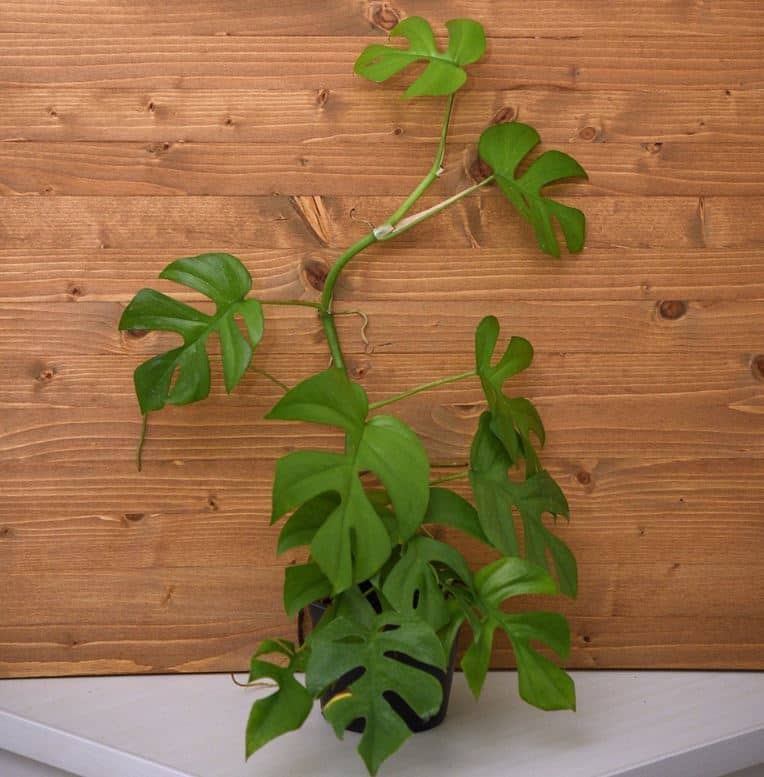
1. Growing habits
Rhaphidophora tetrasperma is a small to medium slender, heterophyllous (a plant with differently looking leaves) liana. It is native to Southern parts of Thailand to peninsular Malaysia and occurs at 652 to 2500 feet (190 to 760m) on primarily sandstone and granite forests.
The seedling stage grows towards the light (non-skototropic), while the juvenile plant shingles and resembles Rhaphidophora korthalsii. But of course, it has differences if you consider their lamina and petioles characteristics.
Its petiole will grow longer and stop shingling as it grows to adulthood. Also, the leaves will split, may have holes, and their shape will change.
2. Growth rate and size
Rphaphidophora tetrasperma has a fast growth rate and can grow up to 16 feet (5 m) high in the wild. But as a houseplant, it will rarely go beyond 6 to 8 feet. Also, it will need a climbing place if you want it larger.
3. Rhaphidophora tetrasperma leaves
The juvenile plant has shingling oval green leaves. Their short petioles make them grow appressed to the climbing surface and overlap. So, these leaves will appear as green roofing shingles, hence the name.
On the other hand, Mature Rhaphidophora tetrasperma don’t shingle, i.e., are free. They are larger, 4.7-16.5 inches (12-42 cm) long and 3.7-15 (9.5-38) wide, broadly oval to oval lance-shaped.
Their lamina is sparsely deep pinnatifid to almost pinnatisect with pinnae that measure up to 2.4 inches (6 cm). And the leaf base truncates with some weakly heart-shaped, while the apex is acute to acuminate. Occasionally, it may have large rhombic holes next to the midrib.
Lastly, the leaves have a shallowly grooved petiole measuring 3.9 to 10.4 inches (10-34 cm), with the upper and lower geniculum slightly prominent. Also, these leaf stalks have a prominent sheath that extends to the upper geniculum base. This sheathing dries and falls, leaving behind a cooky scar.
4. Stems
This plant has thin, 0.4 inches (1cm) smooth stems with only straight leaf scars, i.e., they don’t have scale leaves (cataphylls) or petiolar sheaths, and internodes are about 5.5 inches (14cm). These stems have aerial roots, i.e., anchoring on nodes and internode and one or a pair of stout feeding roots.
Leaves grow in an alternating, weakly spiral manner, and since the internodes are long, the plant looks moderately leafy.
5. Flowers
Rhaphidophora tetrasperma flowers are uncommon in cultivated or indoor-grown plants. But if they bloom, two cataphylls subtend the flowers as they emerge.
Like other plants in the tribe Monstereae, it has bisexual tiny white inflorescence flowers on a spadix surrounded by a white canoe-shaped spathe. The spathe falls shortly after anthesis leaving blackened cataphylls.
Variegated Rhaphidophora tetrasperma
Besides the green form, you can still go for variegated Rhaphidophora tetrasperma, i.e., albo, aurea, and mint. These variegations occur due to cell mutation in the meristem tissue and specifically sectoral chimera. It is unstable, unpredictable, and may revert.
1. Rhaphidophora tetrasperma albo variegata
Its green leaves have cream to white streaks, marbling, blotches, sectors including half-moon.
The cream or white markings occur due to a mutation that makes these areas unable to produce chlorophyll.
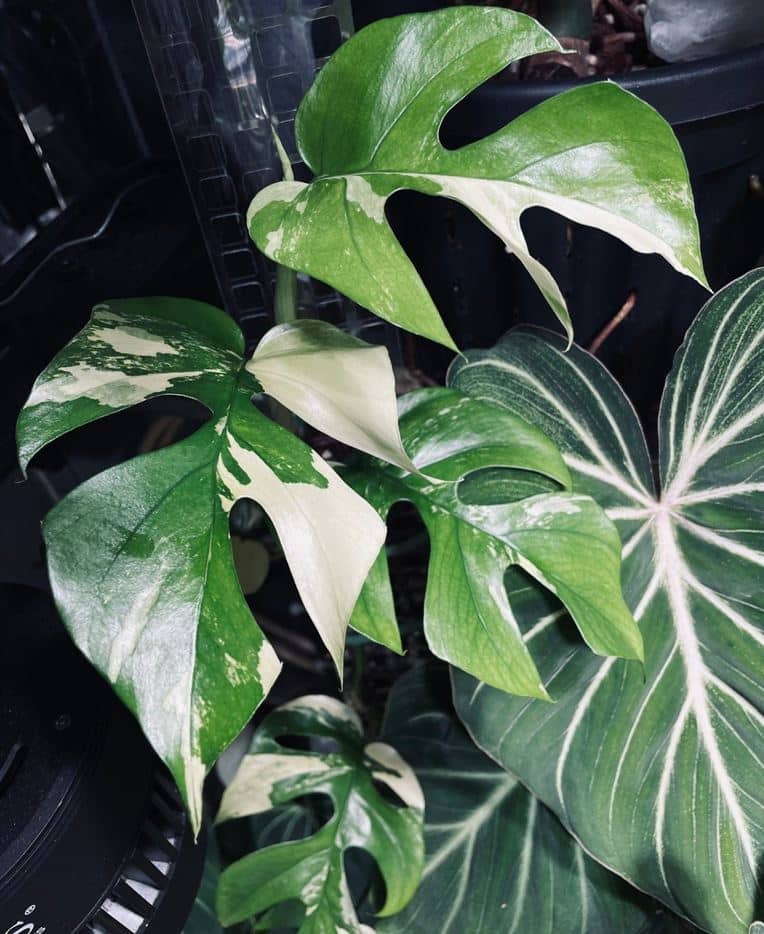
This white variegated mini Monstera is very rare and costly. You will pay between $1500 and $28000, and it once sold at Trade Me for an equivalent of USD 17,729.
2. Rhaphidophora tetrasperma Aurea
If you prefer yellow variegated plants, this philodendron ginny aurea is perfect for you. It has lovely, deeply split green leaves with yellowish variegations, including half-moon leaves.
These colorings occur due to defective chloroplasts that produce less chlorophyll. Also, it may be as a result of the accumulation of carotenoids (causes gold, yellow or orange color).
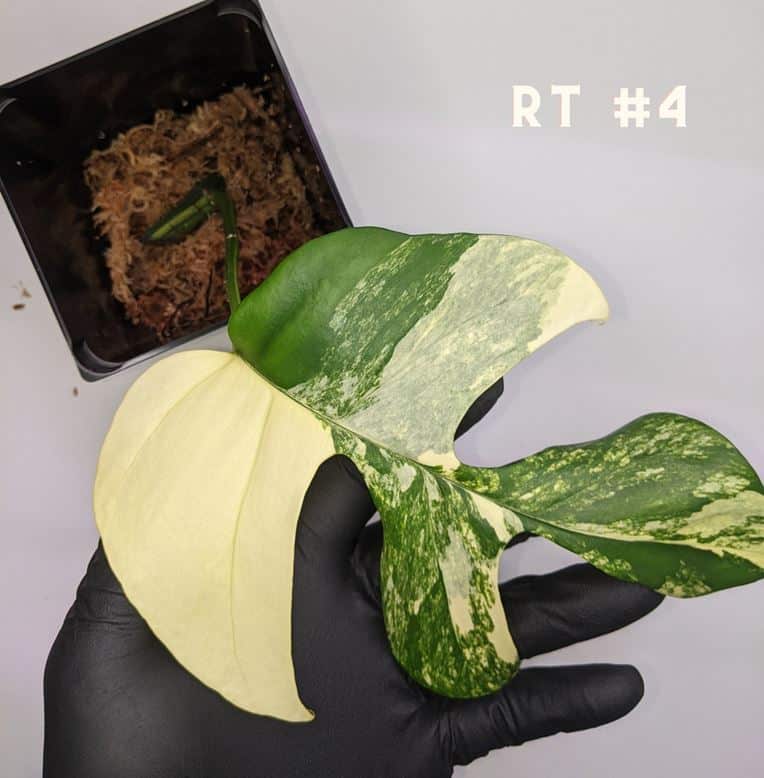
Prices range between $1500 to $9000 with a record sell of USD 5,291 in 2020 as Fox News
3. Rhaphidophora tetrasperma Mint
It has green or green variegation with green leaves have lighter, vibrant green markings. It is equally expensive and rare, selling for $1500 to $8500.

Tissue culture Rhaphidophora tetrasperma
Yes, there is concern about the proliferation of tissue culture Rhaphidophora tetrasperma into the market. But we don’t see the reason for the alarm.
These are plants propagated via tissue culture or micropropagation. It involves taking plant tissue or cells and growing them in a sterile media with nutrients and necessary hormones to produce a clone.
It has pros and cons, and the resultant plants may look slightly different. Even the famous Monstera Thai Constellation is a tissue culture product yet very stable. So, there is no need to fuss.
Rhaphidophora pertusa vs. tetrasperma
Their close resemblance makes it hard for some people to distinguish between these two plant species. But if you look at them keenly, they are different. See the image below. \

Rhaphidophora pertusa has thicker stems with shorter internodes and grows much larger, i.e., large liana. It has broadly oval-oblong to oval-nearly rounded leaves with irregular splits and holes, some extending to the leaf margin. Also, it doesn’t shingle in the juvenile form.
On the other hand, Rhaphidophora tetrasperma is a small to medium slender liana with shingling juvenile leaves. The adult broadly oval to oval lance-shaped leaves have deep splits and may rarely have some with rhombic holes adjacent to the midrib. Its stems are narrower, have longer internodes, and look less leafy than pertusa.
Rhaphidophora tetrasperma vs. Monstera deliciosa
Rhaphidophora tetrasperma is known as mini Monstera or Monstera minima because botanists initially thought it was a miniature version of Monstera deliciosa (Swiss cheese plant or split-leaf Philodendron). But these two have clear-cut distinctions.

For instance, Monstera deliciosa has larger, leathery, glossy heart-shaped deep green leaves with even splits and may have a series of 1-5 holes. Stems are thicker with shorter internodes, and it grows as large, stout hemiepiphyte that may sprawl.
On the other hand, R. tetrasperma grows as a slender, petite to medium liana with smaller, broadly oval to oval-lance green leaves with sparse, deep splits. It may also have rhombic holes close to midrib, but they are rare and shingles in juvenile form, something that a deliciosa doesn’t do.
For more differences and similarities, including care, see Rhaphidophora tetrasperma vs. Monstera deliciosa.
Mini Monstera care
This lovely plant is easy to care for or has low maintenance. A warm, humid place with bright, indirect light will work well. The rest will be watering and feeding correctly, pruning, staking, repotting, and ensuring the right soil mix.
Below is a summary. See Rhaphidophora tetrasperma care for details
- USDA hardiness zone: 11-12, not frost-hardy, and freezing temperatures will kill it.
- Humidity: Average household humidity 40-50% is ok but will appreciate higher humidity (50% or more), especially the variegated plants. Mist it, have a pebble tray, or buy a humidifier like AquaOasis™ Cool Mist Humidifier, Amazon's best seller .
- Temperature: 55-85°F (12.8-29°C) but grows best at 70 to 80°F (21 to 27°C). Avoid cold drafts, sudden temperature changes, or heat stress.
- Light: Rhaphidophora tetrasperma needs bright, indirect light. Avoid direct sun. If in low light, buy a grow light.
- Soil mix: The best soil for Rhaphidophora tetrasperma should be airy, well-drained, and rich in organic matter. We use an aroid mix. See Etsy.com.
- Watering: Deeply water your Rhaphidophora tetrasperma when the top 1-2 inches of the soil feel dry. Always test the potting mix before watering.
- Fertilizer: Feed these plants between 2-3 weeks or up to once a month with an all-purpose, balanced, liquid houseplant fertilizer during the growing season only. We use Bonide Liquid Plant Food 10-10-10
- Pruning: Routinely clean dusty leaves and cut dead, diseased, or damaged leaves with sterilized pruning shears. You can cut back the plant to control growth in the growing season.
- Repotting: Since they grow fast, repot yearly or when rootbound. Use a pot 2-3 inches wider in diameter than the current one and do it in spring or early summer.
- Stake or support: As climbing liana, they will grow best if you give them a moss pole, totem, trellis, etc.
Rhaphidophora tetrasperma Propagation
Rhaphidophora tetrasperma or mini Monstera propagation is by stem cutting in water or soil. But you can opt for air layering, seeds, or even split the plant if it has suckers.
You cannot propagate Rhaphidophora tetrasperma by a nodeless stem, aerial roots, or even leaf with the petiole. But a leafless node is ok.
The best time to propagate your Monstera minima is spring or early summer. It will give your plant enough time to establish before the non-growing season.
We will look at the soil propagation of the mini Monstera and comment on water propagation. The two are much or less the same.
1. What you need
- Soil, potting mix, or sphagnum moss. If sphagnum moss, soak it for 20 minutes and thoroughly wring it to get rid of excess water. Don’t water it afterward.
- Nursery pot
- Growth hormone. While not mandatory, it will help reduce rot and promote quick rooting. A brand like HydroDynamics Clonex Rooting Gel will not only speed rooting but provide nutrients to your plant at this delicate stage.
- Transparent plastic
- Gardening scissors
- 70-99% rubbing alcohol for sterilizing your gardening scissors.
2. How to propagate Rhaphidophora tetrasperma in
Soil propagation promotes faster rooting, gives your plant extra nutrients, and reduces shock when you transplant it.
Here are steps to follow:
- Fill your pot with soil (potting mix) and water it until excess water flowers from drainage holes.
- Select a mature stem with at least two nodes and cut just beneath the lower node with your sterilized gardening scissor. If it has more than two leaves, remove the lower ones.
- Apply your rooting hormone on the cut end, covering up the node that will go into the potting mix.
- Poke a hole in your potting mix with a stick or finger, and plant your Rhaphidophora tetrasperma stem cutting. Afterward, lightly press some soil onto the cutting to ensure it holds it firmly upright.
- Cover your cutting with your transparent plastic leaving a tiny breathing hole, and ensure leaves don’t touch the plastic bag. Use a chopstick or stick to prevent the bag from touching the leaves.
- Place your plant in a warm place with bright indirect light. If possible, maintain the 70 to 77° F (21-25°C) for faster growth.
- Routinely remove the plastic bag to let your plant breathe for a few hours. Also, mist the soil if it begins to dry.
Your plant will take about 3 to 5 weeks to root, grow some new foliage and be ready for transplanting.
The exact time will depend on the conditions you maintain, but it should be ready when roots are about 3-4 inches long.
3. Philodendron ginny water propagation
Water propagation allows you to see roots grow and is less messy. But it is tedious (you need to change the water) and takes longer. Also, your plant will suffer from a shock when you finally transplant it.
After step 3 above, dip your plant in a jar with water. But don’t immerse leaves too. Next, place the cutting in an area with bright, indirect light. And be changing the water after 3-4 days and top up if the level falls.
By the end of the 4th to 6th week, your plant will have grown long enough roots, new foliage and be ready for transplanting.
Is Rhaphidophora tetrasperma toxic to cats, dogs, and humans?
Yes. Rhaphidophora tetrasperma or mini Monstera is toxic to cats, dogs, other pets, and humans. Why? Because it has sharp or needle-like insoluble calcium oxalates.
What will happen if you chew the plant? It will cause severe oral irritation and a burning sensation, swelling, and redness of the mouth, lips, and tongue. Other signs include drooling, swallowing difficulties, lack of appetite, and pets will paw their mouth.
Please, keep this plant and other toxic aroids like Monstera, Philodendrons, Alocasia, etc., out of your kids’ and pets’ reach or go for sale alternatives.
Problems and issues
Even with excellent care, your plant may have problems, especially leaf discoloration, drooping, or curling. Even pests and diseases, especially root rot, may happen. Let us have an overview of these problems.
1. Pests that affect Monstera minima
Your plant may have sap-sucking pests like mealybugs, spider mites, scale insects, whiteflies, aphids, or thrips. They will appear as variedly colored and shaped bumps, dots, spots, with some having wings or waxy bodies.
Early generalized signs include whitish, black, brown, or yellow spots, silvery stippling, webbing, honeydew, sooty mold, etc., and largely depend on the specific bug present. Heavy infestation may cause leaves to drop, turn yellow, be curly, or misshapen.
Always inspect new plants, especially the undersides, for these bugs and isolate affected plants.
If you see any pests, use insecticidal soaps, neem oil, or horticultural oil spray to treat them. Bonide BND022- Ready to Use Neem Oil, is a 3-in-one solution with miticide, fungicide, and insecticide to help deal with these unwelcomed visitors.
2. Diseases
Root rot is the most common problem if you have poorly draining soil, overwater your plants, use pots without drainage holes, etc.
To tell your Rhaphidophora tetrasperma has root rot, look for signs such as stunted growth, mushy stem base, yellow leaves, wilting, leaf drop, etc. Some may affect leaves or stems, causing brown to black lesions.
If the whole root ball hasn’t decayed, repot your plant to a new potting mix. Begin by washing off old soil, and cutting any rotten (mushy, black, or brown parts). Then you can afterward dip the plant in a fungicide before repotting.
Besides root rot, your plant may have bacterial and fungal leaf spots. They will cause brown, dark brown, or black lesions, some with a yellow halo. Use fungicide for fungal disease. If you see a water-soaked lesion, your plant has a bacterial infection. Discard it.
Last but not least, practice proper sanitation (disinfecting gardening tools, washing hands, sterilizing pots, etc.) to help reduce diseases. Also, isolate sick plants.
Other problems
Besides pests and diseases, other problems that your mini Monstera may have include:
- Yellow leaves: Rhaphidophora tetrasperma yellow leaves indicate overwatering. But it may be due to too little light, low humidity, nutritional deficiencies, heat stress, pests, diseases, etc.
- Brown tips, edges, spots, or leaves: The most common reason is leaf scorch due to underwatering, sunburn, low humidity, or heat stress. Less probable causes include fertilizer burns, cold drafts, overwatering, diseases, and pests.
- Leaves turning black or having black spots: Possible reasons of Rhaphidophora tetrasperma black spots or leaves include pests and diseases. Less common are overwatering (may cause black splotches) and frost damage.
- Drooping: Your plant doesn’t get enough moisture, cannot or loses more than it absorbs. Common causes are underwatering, low humidity, too much light, and heat stress. Other less likely reasons are overwatering, root rot, rootbound, or transplant shock.
- Leaves are curling: Curling is a means for plants to protect or minimize leaf moisture loss. Causes are similar to those of leaves drooping, including underwatering, low humidity, too much light, etc.
Finding Rhaphidophora tetrasperma on sale
When looking for Rhaphidophora tetrasperma, remember it goes by various common names it will like mini Monstera, mini Monstera, Monstera ginny, Monstera minima, Philodendron ginny, philodendron minima, or Philodendron piccolo
Secondly, it shouldn’t be hard to find the standard green form mini Monstera. Start by looking at your local tropical plant specialty nurseries. Here, you will find a few vendors with this plant. Don't expect to get the variegated forms at local nurseries.
The next place to head to is Etsy.com. It is our favorite marketplace that brings together many vendors and buyers. You cannot miss getting a vendor near you, whether you are in Australia, Canada, the US, the UK, New Zealand, Singapore, etc., Etsy.com also has rare, variegated mini Monstera (albo, mint, or aurea variegata).
The other place to try is eBay. It has vendors from across the globe with an option of bidding for plants. Here you will also get the rare variegated forms.
Next, go to social media, i.e., Facebook and Instagram. Here you will find many vendors, including the rare variegated forms. Ensure you pick a reputed vendor with positive feedback.
Other great places to buy mini Monstera include Home Depot, Bunnings (Australia), Walmart, and Amazon. Also, sites like Planterina, Gabriella Plants, and Pistils Nursery have it. Note that some of these places may use a synonym.
If you haven’t found a vendor, try using the search engine. Google ‘Rhaphidophora tetrasperma for sale’ and see what recommendations you get. Alternatively, while searching, use the synonyms, i.e., Monstera ginny, mini Monstera, Philodendron ginny, philodendron minima, or monstera minima for sale.
Lastly, if you decide to buy Rhaphidophora tetrasperma online, ensure you see the actual and not the mother plant. Also, go for a positively reviewed and reputed vendor.
Mini monstera prices
The Prices of monstera minima range from $10 to $25 for the green form. But if you want the variegated Rhaphidophora tetrasperma, be ready to spend from $1500 onwards.


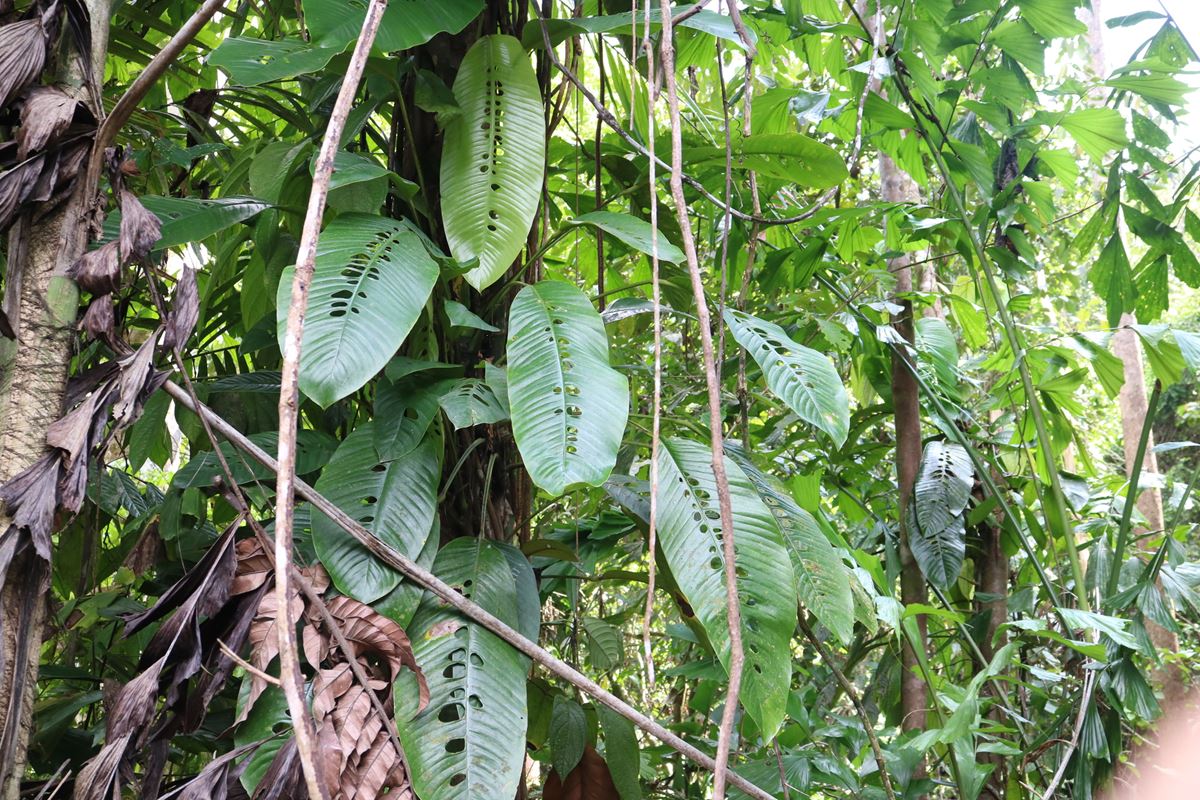

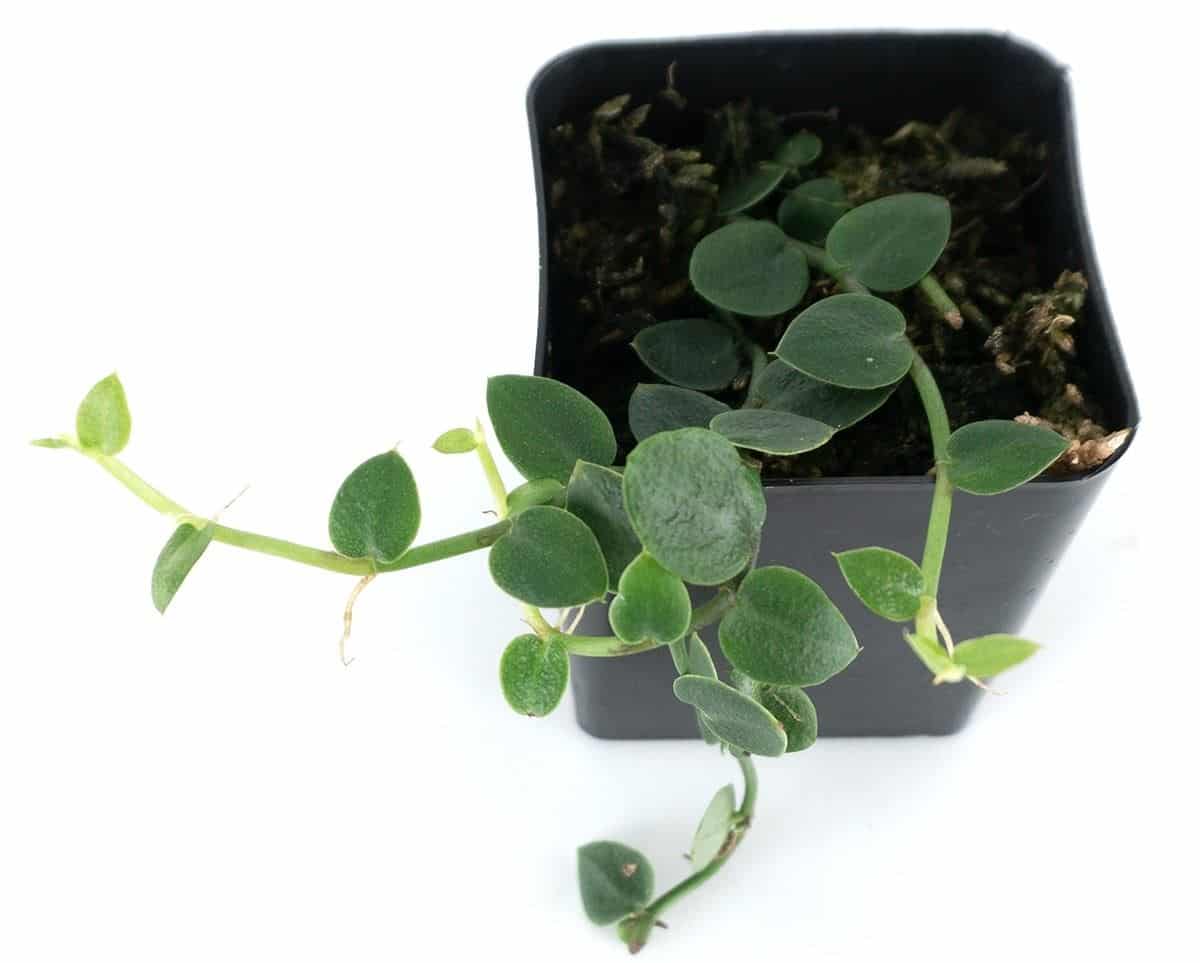
Leave a Reply